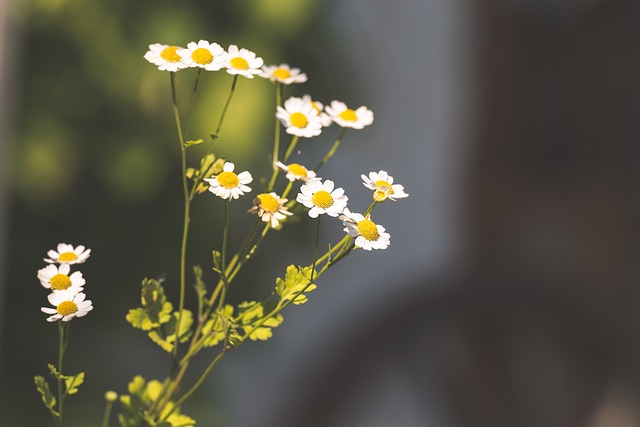FEVERFEW
Feverfew, which commonly grows in many places worldwide, is a short, bushy perennial (persisting) with a strong, bitter aroma. The leaves of the feverfew plant are less than 8 cm and mostly hairless. These yellow-green leaves grow alternately up the stem protruding from either side.
Feverfew blooms from July to October, and the flowers grow in a tight cluster that reaches 2 cm in diameter. The feverfew plant is sometimes confused with chamomile due to its visual resemblance.
However, the powerful aroma of feverfew is a key identifying feature.
Medicinal Uses and Effects
The medicinal effects of feverfew are impressive. It has been widely used to treat migraine headaches and fevers for centuries. Aside from treating stubborn migraines, feverfew also helps many other conditions, including:
Anxiety and stress: While the way that feverfew works to provide anxiety and stress relief is not fully understood, it has an apparent effect on these issues in some users. Perhaps it is the reduction of pain, but some people who take feverfew report a decrease in chronic stress.
Inflammation: The volatile compounds found in feverfew are anti-inflammatory and work to reduce inflammation throughout the body. Thus, it can provide much-needed relief for those who suffer from chronic joint-pain, arthritis, and other inflammatory diseases.
Pain relief: Closely related to the reduction of inflammation, feverfew is also known to reduce pain. This popular herb has been used for thousands of years to treat and even prevent pain throughout the body.
Improve respiratory function: This fantastic herb helps reduce inflammation and irritation in the lungs, making breathing more effortless if you have asthma or are experiencing a cough.
Skin ailments: Only recently was it discovered that feverfew aids in skin health and can actually protect the skin and help it heal. Recent studies have shown that the herb can help to improve symptoms of dermatitis and other common skin conditions when applied topically.
Fight Fever: As its name implies, feverfew is often used to treat and fight fever. It is said to break and eliminate fevers, regardless of their cause.
Growing Feverfew
Due to their small size, the seeds are best planted in small peat-pots. Simply drop a few feverfew seeds into a pot and tap the bottom to help them settle. Using a spray bottle is far better than pouring water over the seeds because they are small and can be easily dislodged by the flowing water.
Feverfew plants should be placed in a sunny window or under a grow light and will take two weeks to begin growing. Once the plants reach approximately 1 inch, plant them, pot and all, in a sunny spot in the garden and water regularly.
If you want to start your plants in the garden, plant in early spring by spreading the seeds on top of the soil and lightly tamping. You mustn’t bury or cover the seeds entirely as they require sunlight to germinate properly.
Mist with water to ensure they do not wash away and then wait. In the garden, this process should take around 14 days. You can thin the plants once they reach 3-5 inches, spreading them until they are approximately 15 inches apart.
Feverfew is relatively easy to grow. The only requirement is that they are placed in a spot that receives lots of direct sunlight. Therefore, refrain from planting under a large tree or in any other shady part of the yard.
As a perennial, feverfew will need to be cut back after a frost and generally reseeds quickly. You may find that you have too much and may need to gift the extra to friends or family. You can prevent excess seeding by dead-heading the blooms once they are wilted.
How To Harvest And Store Feverfew
Although all parts are useable, the leaves are the part most commonly used in medicine and commercial products. While fresh herbs are always better, having access to fresh herbs is not always possible.
However, you can safely dry and store feverfew while retaining its medicinal benefits. Feverfew should be harvested right before or during flowering. You will want to wet down the plant with a gentle hose or mist to help clean them of any lingering bugs before harvesting.
When harvesting feverfew, it is best to do so in the early morning and when the flowers are full, and there is a significant amount of green still surrounding them. To harvest it, only cut 1/3 of the plant to prevent killing it.
Gather your cut pieces and wash thoroughly, then tie them together and hang them to dry in a warm, dark spot. Alternatively, you can lay them out to dehydrate until crispy, although hanging is usually faster. Once dried, store the feverfew in an airtight container in a dry, dark space that is warm but away from sunlight.




